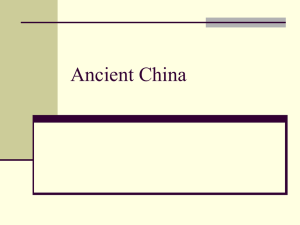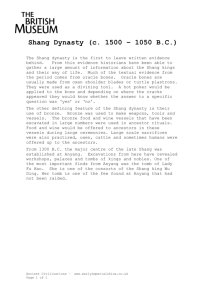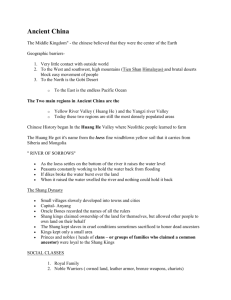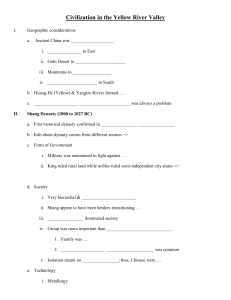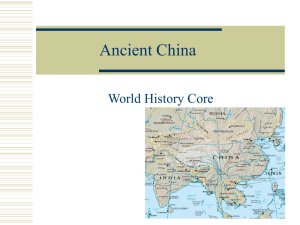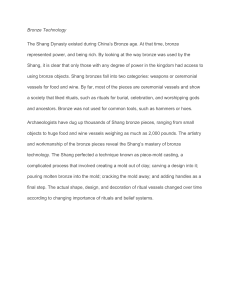Ancient China
advertisement
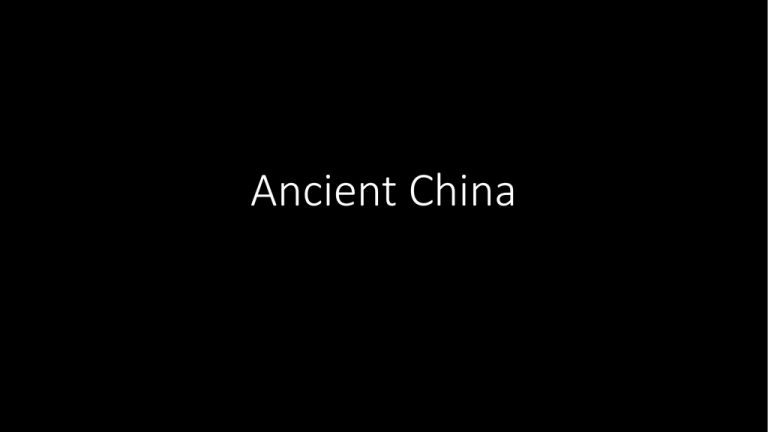
Ancient China Geography of China • Natural barriers kept China isolated from other civilizations, with the Pacific to the east and the Taklimakan desert and plateau of Tibet in the west • Huang He and Yangtze rivers China’s Heartland • Plain between two rivers was China’s heartland, where 90% of arable land lies • China remained a center of civilization throughout its history of expansion and decline • They viewed outsiders as barbarians • Their own name for China was the Middle Kingdom because they saw it as the center of the civilized world Environmental Challenges • Civilization emerged along the Huang He • Huge amounts of loess, fertile soil, blown from the winds of the western deserts helped • Flooding unpredictable • Huang He earned the nickname “River of Sorrow” due to the terrible flooding • Were occasional invasions from the west and north • Few contacts with outsiders, so developed on their own Civilization Emerges in Shang Times • Humans have inhabited China for about a million years even though civilization began there later • Homo erectus skeleton found near Beijing. Known as “Peking man”. Shows settlement of river valley about 500,000 years ago First Dynasties • Xia dynasty was begun by an engineer and mathematician named Yu around 2000 BCE but there are no written records of this time so little is known • Shang Dynasty 1532-1027 • First family to leave written records • Built elaborate tombs and palaces Early Cities • Anyang was one of the capitals of the Shang • Built of wood • Evidence of social classes because of different housing for rich and poor • Shang surrounded cities with huge earthen walls for protection • The building of those walls demonstrates that the Shang could organize labor to build it • Walls needed because they were waging war; also, chariots developed (probably through contact with the west) Social Classes • Sharply divided between nobles and peasants • Ruling class of warriors headed by a king • Noble families owned land • Tribute send to king • Farmers tilled the land with rudimentary tools (bronze was too precious for agriculture and would only be used for weapons and ceremony) Origins of Chinese Culture • Group more important than the individual • Duties to two authorities: family and king or emperor Family and Society • Chief loyalty in life was to family • Respect for one’s parents was the most important virtue • Men superior to women • Girls had arranged marriages and could only improve status by bearing a son Religious Beliefs • Family linked to religion • Ancestor worship because they thought ancestors controlled your fortune • These spirits were not gods but through the spirits the Shang consulted the gods • Supreme god, Shang Di, and lesser gods • Used oracle bones and shells to consult the gods Development of Writing • Earliest evidence of writing comes from oracle bones • Each character is an idea rather than a sound • No links between spoken language and written language • Advantage= all people could learn the same system of writing even if their spoken language was different. This will increase the unity of the people. • Disadvantage- it was too complex for ordinary people to learn, so only nobles’ children were literate Shang Technology and Artistry • Bronze working was the leading craft used for religious rituals and royal power • Silk cloth from a silkworm’s cocoon Zhou Dynasty • Zhou overthrow Shang in 1027 • They maintain the culture of the Shang but bring new ideas, especially related to governance • Introduce Mandate of Heaven Concept: • Royal authority came from heaven • Bad leaders can be overthrown • This justified the overthrow of the Shang • Explanation for rebellion, civil war, and the rise of a new dynasty • Dynastic Cycle is the pattern of rise, decline, and replacement of dynasties Feudalism • Because they controlled such vast territory and they needed to control it, they devised a system called feudalism, where nobles or lords are given land that belongs to the king in exchange for loyalty and military service • Local lords lived in small towns and submitted to the strength of the Zhou rulers • Over time they grew stronger and expanded their territory • They gained the allegiance of the people in that territory • Eventually they would amass enough power to challenge the status quo Technology and Trade • Warfare common but produced a lot of technology • Roads, canals, coined money • New class of civil servants • Use of iron- developed furnaces to produce cast iron (this wouldn’t be done in Europe until the Middle Ages) • Used for weapons and agricultural tools • Iron stronger than bronze, so superior • Led to more agricultural productivity Warring States Period • Zhou ruled from 1027-256 BCE • First 300 years good but then attacks from nomads begin about 771 BCE, when northern nomads take the capital city and murder the monarch • Royal family flees and sets up new capital at Luoyang but is severely weakened • Local lords grew in military power and began fighting each other and could no longer be controlled by the emperor= warring states period • Warfare also changed • Crossbow introduced • Peasant foot soldiers replaced chariots • Traditional values declined during this time

